WLAN 802.11ad/802.11ay Test Solution
with ADP7104, M8195A, WR15CCU, WR15CCD, N5183B
- Generate and analyze fully coded 802.11ad/ay Wireless Gigabit Alliance (WiGig) waveforms with flexible parameter configuration
- Pre-correct waveforms for overall channel response
- Supports many topologies for transmitter / receiver testing (IQ, IF, RF, microwave, millimeter-wave)
- Independent reference to debug and validate hardware performance
- 2 channel RF modulation bandwidths up to 9 GHz (4 channel 6.5 GHz)
- Frequency bands between DC and 10 GHz with base instruments
- Frequency bands between 50 – 75 GHz with extended millimeter-wave configurations
- Over-the-Air (OTA) measurements using waveguide horn antennas

IEEE 802.11ay is a proposed enhancement to the wireless local area network (WLAN) 802.11.ad standard. It will enable 8.64 GHz maximum bandwidth in the unlicensed and globally available 60 GHz band. Up to 40 Gbps data rates over distances (300m – 500m).
The WLAN 802.11ad/802.11ay Test Solution allows to generate and analyze multichannel 802.11ad and 802.11ay fully coded PHY waveforms for complete component, subsystem, and system performance at baseband, IF, and millimeter-wave (mmWave).
This Compact Reference Solution combines commercial off-the-shelf (COTS) modular hardware and software from Guzik, Keysight Technologies and Virginia Diodes, which provides a flexible testbed for 802.11ad/ay waveform generation and analysis with greater accuracy than the competitive offerings. With a residual error vector magnitude (EVM) measurements down to 1.5% (-36.5 dB) for 802.11ad and 2.1% (-33.5 dB) for 802.11ay without channel pre-corrections. The test setup allows to de-embed external cables, attenuators or amplifiers in front of the digitizer with Guzik patented FPGA-based interleaved ADC amplitude and phase response equalizer.
Software provides the flexibility to generate and analyze 802.11ad/ay waveforms with a wide range of different attributes.
Modular hardware provides the flexibility to support baseband, IF, and millimeter-wave test planes. Create waveform sequences with unique 802.11ad/ay packet structures including Modulation Coding Scheme (MCS), packet length, payload data type, and interpacket gap length, etc.
Frequencies up to 10 GHz can be supported with the base test equipment configuration for testing with a wide range of IF’s and the 60 GHz V-Band frequencies can be generated and analyzed with the Virginia Diodes compact up-converters and down-converters.
This Reference Solution can be used as an independent reference to help debug and validate hardware performance issues as they occur.

Measurement applications and software:
- Keysight 81199A Wideband Waveform Center software creates and analyzes 802.11ad waveforms
- Keysight 89600 VSA software to demodulate custom IQ and custom OFDM waveforms
WR-15 Waveguide Band Reference Setup.
- VDI15.0AMP-0055/0067-15-20 Amplifier Band 55-67 GHz, Gain ~17 dB
- VDI15.0BPFE57.24-65.88 bandpass filter with Insertion Loss < 1 dB
- Sage STA-60-15-P1 50 to 75 GHz, 0 to 60 dB, WR-15 Waveguide, V Band Programmable Attenuator

The measurements below in the mm-wave range are performed via waveguide interface WR-15 for simplicity.
Radiated emission over-the-air (OTA) measurements with waveguide horn antennas can lead to high attenuation. Each ADP7104 digitizer channel has adjustable front-end (-32 dBm to +22 dBm with 1 dB steps), which allows to fine tune the receiver for best EVM. The variable waveguide attenuator is used below to demonstrate some degree of Free Space Loss (FSPL) and expected EVM degradation.
802.11ad mmWave Performance:

802.11ay mmWave Performance:

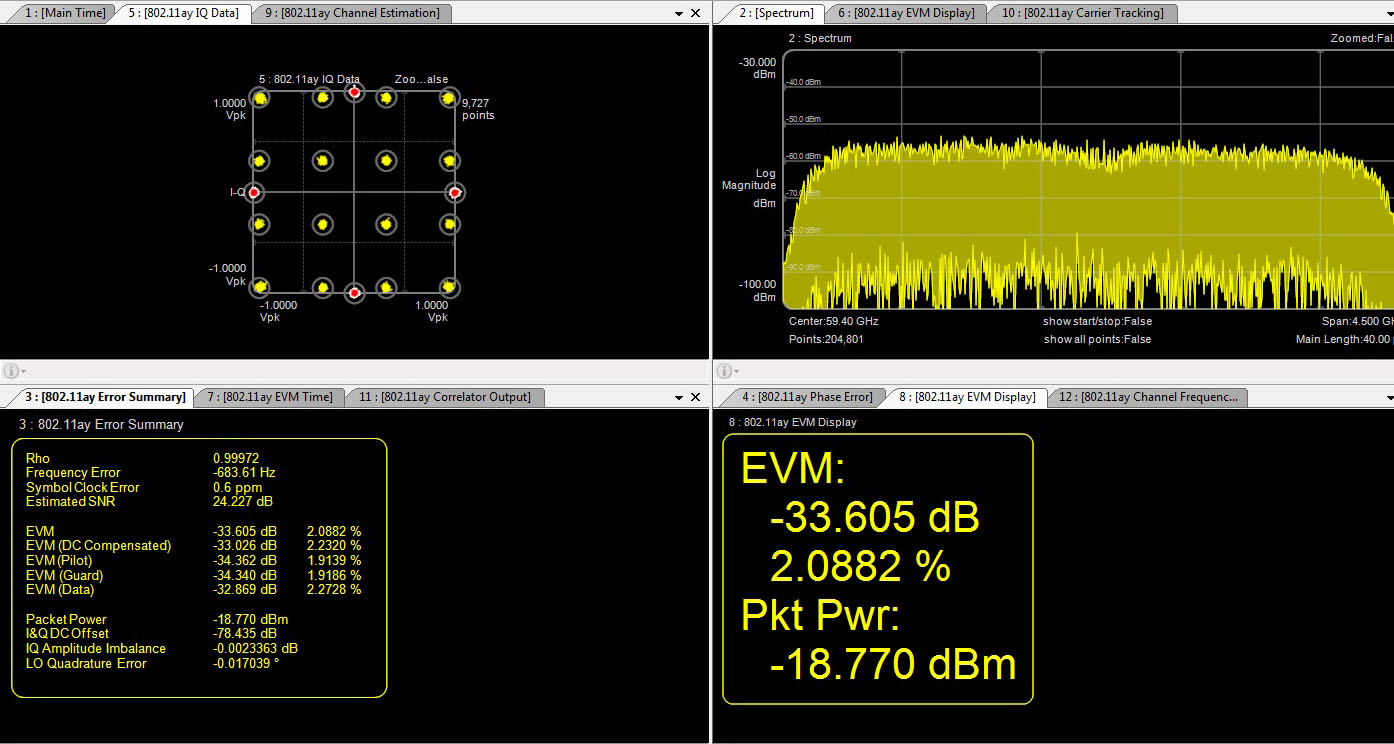
802.11ad IF Loopback Performance:
802.11ay IF Loopback Performance:
Note: Application Sample measurement results provided are representative and performed under ideal conditions without “Pre-Corrections” at +25˚C ambient temperature. The results are not warranted specifications.
1 Channel Configuration:
The analysis speed greatly depends of the processing capability available to the test solution, either as an integrated measurement personality or as software running internally on a computer connected to signal analyzer. As the 802.11ad and 802.11ay waveforms grow in complexity and bandwidth, the signal analyzers have a tough time keeping up with delivering the analysis speed necessary for high-volume manufacturing.
The Guzik ADP7104 Series 10-bit Digitizer employing techniques similar to the digital radio receivers for decoding digital modulations. The digitizer can directly sample RF signals at DC to 10 GHz on multiple channels simultaneously. This technique provides all digital fast high accuracy repeatable measurements and display of modulation characteristics by reducing both front-end active analog signal chain components and supporting elements.
With the FPGA-based digital signal processing capabilities in the Guzik ADP7104 Series 10-bit Digitizer, the overall measurement process is accelerated to enable the sub 1 second measurement speed requirements for 802.11ad and 802.11ay analysis both during R&D and volume manufacturing.
802.11ad MCS12 IF Loopback Measurement Speed ~5 updates/sec:
The 802.11ay MCS12 IF Loopback Measurement Speed is ~4 updates/sec.
The 802.11ay MCS20 IF Loopback Measurement Speed is ~4 updates/sec.
The 802.11ay MCS20 59.4 GHz mmWave Measurement Speed is >4 updates/sec (with ADC_BB firmware option enabled).
Note: Application Sample measurement results provided are representative and performed under ideal conditions with “Pre-Corrections” at +25˚C ambient temperature. The results are not warranted specifications.


